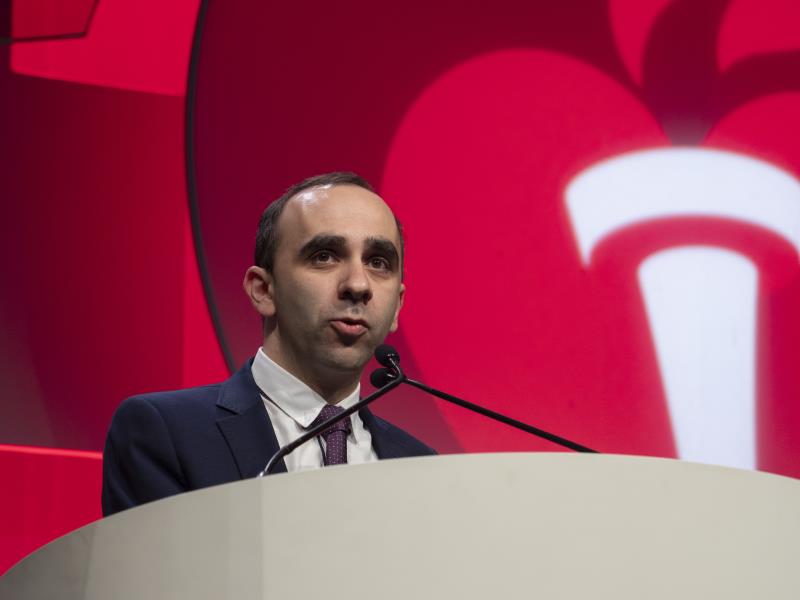 Dr Nawaf Yassi (copyright American Heart Association-Photo by Todd Buchanan 2020)
Dr Nawaf Yassi (copyright American Heart Association-Photo by Todd Buchanan 2020)Prompt treatment with tranexamic acid may reduce intracerebral haemorrhage (ICH) growth in patients with ongoing bleeding, though the timing of treatment appears to be key to improved outcomes, according to a study presented at ISC 2020.
The phase II STOP-AUST* trial involved 100 patients with ICH who exhibited a spot sign – a marker of ongoing bleeding – on computed tomography (CT) angiography. They were randomized 1:1 to receive either intravenous tranexamic acid (1 g over 10 minutes followed by 1 g over 8 hours; median age 72.5 years, 30 percent female) or placebo (median age 71 years, 46 percent female) within 4.5 hours of ICH onset (median time to treatment 150.5 minutes). Median NIHSS** at baseline was 14 and 12 in the tranexamic acid and placebo groups, respectively, while median ICH volume was 13.8 and 15.6 mL, respectively.
ICH growth – defined as a >33 percent or >6 mL increase from baseline in 24 hours after adjustment for baseline ICH volume – occurred in 44 and 52 percent of patients who received tranexamic acid and placebo, respectively (adjusted odds ratio [adjOR], 0.72, 95 percent confidence interval [CI], 0.32–1.59; p=0.41). [ISC 2020, abstract LB20]
Absolute haematoma growth was numerically, but not significantly, reduced in tranexamic acid vs placebo recipients (median 1.9 vs 3.4 mL; adjusted median difference -1.8 mL, 95 percent CI, -5.2 to 1.5 mL; p=0.28).
“[Tranexamic acid] treatment led to a non-statistically significant reduction in ICH growth, both in binary and absolute terms,” said study author Dr Nawaf Yassi from the University of Melbourne in Parkville, Victoria, Australia.
Subgroup analyses noted a trend toward reduced haematoma growth among the 66 patients who received treatment ≤3 hours of ICH onset (adjOR, 0.41, 95 percent CI, 0.15–1.12), but not among those who received treatment 3–4.5 hours after onset (adjOR, 2.45, 95 percent CI, 0.52–11.57; pinteraction=0.06).
Post hoc analyses suggested that the best outcomes were derived when patients received tranexamic acid ≤2 hours from ICH onset (OR, 0.19, 95 percent CI, 0.03–1.15; p=0.07), with the risk reduction less apparent when treatment was administered at <3 hours (OR, 0.41) and <4 hours (OR, 0.64) from onset.
“Further trials using tranexamic acid are ongoing and focusing on ultra-early treatment – within 2 hours. This is where the greatest opportunity for intervention appears to be,” said Yassi.
There was no difference between tranexamic acid and placebo recipients in terms of major thromboembolic events (n=1 and 2, respectively; OR, 0.49; p=0.57), though there was a nonsignificant higher mortality rate in the tranexamic acid group (n=13 vs 8; adjOR, 2.38; p=0.19).
“I think a big reason for these kinds of results in the setting of haemorrhage is that, very quickly after the haemorrhage begins and the haematoma expands a bit, a lot of damage may already have occurred. And so even if we stop the bleeding later, much of the injury has occurred, and it may just be a bit too late. But the proof of principle is there,” said Professor Mitchell Elkind from Columbia University, New York City, New York, US, and president-elect of the American Heart Association, who was not affiliated with the study.
“[I]n a sense [this is] a very exciting result because it suggests that we may be able to have an impact, although from a practical level, it means we have to get to those patients super early, perhaps even earlier than we’re accustomed to doing for ischaemic stroke patients. And that I think is [going to] be the big challenge with a lot of these therapies,” he added.